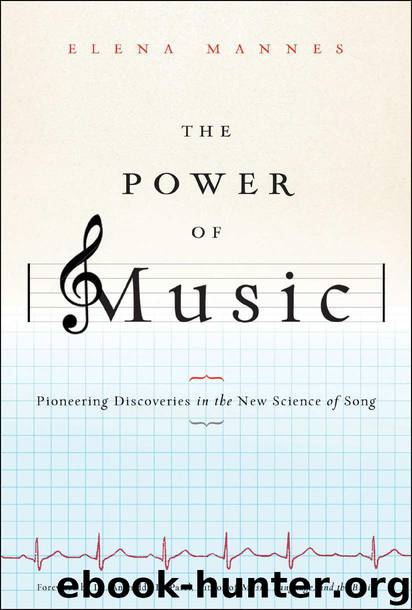The Power of Music: Pioneering Discoveries in the New Science of Song by Mannes Elena

Author:Mannes, Elena [Mannes, Elena]
Language: eng
Format: azw3
Publisher: Bloomsbury Publishing
Published: 2011-05-23T16:00:00+00:00
FIGURE 4 Spectograms of humpback whale song. CREDIT: SCOTT MCVAY AND ROGER PAYNE
Scott McVay confesses that the humpback vocalizations initially sounded to him like a cacophony of sound. But after a few weeks, he and Payne figured out the pattern. And it turns out all the whales they analyzed were singing the same song, which can last from six to thirty minutes.19 Later, researcher Katy Payne (also a whale researcher, then married to Roger) discovered that the songs evolve over time, so that within a span of four to six years, all the humpback whales in all the oceans are singing a totally different song. This is true of the song cycles in the Atlantic, Pacific, and Indian Oceans.20
So why are they singing? McVay and Payne said in their paper that it might have something to do with attracting a female. But, as McVay points out, to date there’s been no evidence, on film or in any other way, that a female has been drawn by the singing! So maybe, McVay says, the song has something to do with the hierarchy among males. But he also comes back to an observation made in the paper. “We have become aware of what we believe to be the humpbacks’ most extraordinary feature—they emit a series of surprisingly beautiful sounds, a phenomenon that has not been reported previously in more than a passing way.”21
Scientists like McVay and Ofer Tchernichovski readily spoke of their own response to the sounds of other species in terms of their intellectual and emotional reaction to beauty. In fact, it was remarkable, McVay notes, that this observation of beauty was accepted for publication in a scientific journal. McVay, who majored in English literature, hears poetry in the song of the humpback.
Scott McVay wrote a poem about whale song, back when he was working on that groundbreaking paper. In “Whale Sing,” he says:
Up and up and up the scale
beyond the topmost upper note
and beyond that
straining for ultimates
leaving a low wailing
a small sob before
and beneath
to the reachingest next-to-god note of all,
a Humpback sings his song.
The Song of Songs.
The Hymn of Hymns.
Science, McVay says, “is doing some kind of bean counting, looking for patterns. With poetry, you let the floodgates reveal how you are responding on a very subjective, full-throated scale.”
McVay is very much the scientist. But he wants others to hear the poetry—and the music—in the song of the humpback:
It would appear that in the natural world there is this propensity for communicating and communicating in the best way possible within the constraints of that frame of reference … The point is when you get a master like Bach or Shakespeare or Goethe, or the humpback whale, it seems like there’s the impetus within life to communicate. Sometimes it’s subtle. Sometimes it’s raucous. Sometimes it’s beautiful. But it is profoundly affecting within the domain of that species to communicate among themselves.22
The recent research in the field of biomusicology is letting us hear a whole new world of music-like sounds produced by other species.
Download
This site does not store any files on its server. We only index and link to content provided by other sites. Please contact the content providers to delete copyright contents if any and email us, we'll remove relevant links or contents immediately.
The Goal (Off-Campus #4) by Elle Kennedy(13213)
Kathy Andrews Collection by Kathy Andrews(11346)
Diary of a Player by Brad Paisley(7272)
What Does This Button Do? by Bruce Dickinson(5938)
Assassin’s Fate by Robin Hobb(5867)
Big Little Lies by Liane Moriarty(5528)
Altered Sensations by David Pantalony(4878)
Pale Blue Dot by Carl Sagan(4633)
Sticky Fingers by Joe Hagan(3918)
The Death of the Heart by Elizabeth Bowen(3350)
The Heroin Diaries by Nikki Sixx(3328)
Beneath These Shadows by Meghan March(3158)
Confessions of a Video Vixen by Karrine Steffans(3110)
The Help by Kathryn Stockett(3024)
How Music Works by David Byrne(2969)
Jam by Jam (epub)(2882)
Harry Potter 4 - Harry Potter and The Goblet of Fire by J.K.Rowling(2818)
Strange Fascination: David Bowie: The Definitive Story by David Buckley(2704)
Petty: The Biography by Warren Zanes(2579)
